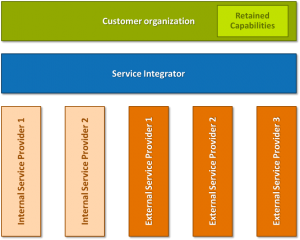In our latest “Slice of SIAM” Michelle Major- Goldsmith & Simon Dorst look more closely at the challenges of service level management in a SIAM model. Read Part 1 of the SLA trilogy here.
Part 2 – the big SIAM picture, and accountability & responsibility.
In the first part of our trilogy we explained the basic terms and challenges related to Service Level Agreements (SLAs) and Key Performance Indicators (KPIs). In this ‘SIAM slice’ we will build on this and share some critical success factors for defining SLAs in a SIAM ecosystem.
There are three layers in a SIAM ecosystem:
1. Customer organization (including retained capabilities)
2. Service integrator
3. Service provider(s).

Source – SIAM Foundation Body of Knowledge
Each layer has a role as part of effective end to end management of services and the delivery of maximum value. It is in such an environment that the challenge of measuring service delivery from a business perspective needs careful consideration. Defining SLAs in any IT services environment can be tough but trying to do this is in an environment where multiple providers are working together requires diligence and understanding. The challenge in a SIAM model is that the Customer Organization expects the Service Integrator to manage this on their behalf.
Let’s consider some of critical success factors (CSF’s) concerning SLAs within a SIAM ecosystem.
CSF #1 – Understanding the ‘Big Picture’
Understanding the service environment is key. Being able to create an accurate view of how the services are made up, the interfaces, dependencies and vital business functions, is an important building block in terms of creating that understanding. It paints the picture regarding who does what, within the layers.
Having this information creates confidence in the accuracy of the service landscape, so that the definition of service requirements is possible. And then these can be easier divided into individual requirements and performance indicators that can go into the SLA’s of the various Service Providers involved in the delivery of the service. With sometimes in excess of 20 providers, this can be a complex but necessary task.
CSF #2 – Defining accountability and responsibility for SLAs
In the SIAM ecosystem, the Customer needs to understand that its role is to support and empower the Service Integrator. The Customer will develop SLAs between the IT organization’s retained capabilities, as custodians of the service, and the business; but then needs to leave the delivery of, reporting against and operational governance to the Service Integrator.
The role of the Service Integrator involves being the agent of the customer, acting on its behalf. Conversely, the Service Integrator also represents the Service Providers and the end to end service back to the Customer Organization. The Service Integrator is accountable for the delivery of the end to end service and thus the achievement of service levels with the business.
Service Providers are responsible for achieving their individual service targets. However, end to end service delivery requires all the elements to be performing as agreed, so it is incumbent on the providers to support each other in pursuance of those end to end targets. Failure for one can mean failure for all.
Whilst the Service Integrator has an overarching role in this, in a SIAM ecosystem it is important that individual providers understand their responsibility in this. There are one-to-one SLA’s between the Service Providers and the Customer Organization, but SIAM environments require collaborative working and providers may need to adapt to working other providers that may be potential competitors, as well as having to adjust to having a relationship with the service integrator rather than the business.
There are many success factors associated with SLAs within a SIAM environment. Don’t forget to call back soon for part 3 of the trilogy where we will be considering some more.


